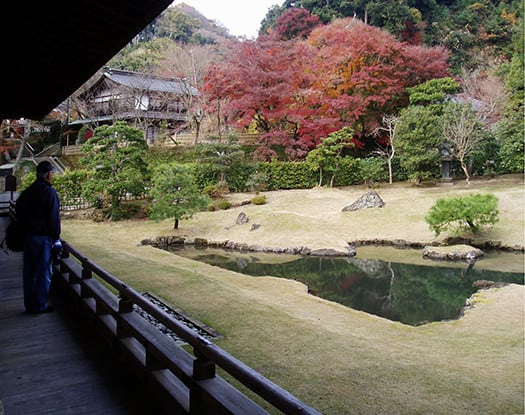
〜聖徳太子が制定した十七条憲法の第一条に出てくる言葉で「尊し」でも良いが,
原典は「貴し」。故事ことわざ辞典によれば「何事をやるにもみんなが仲良くやり,
いさかいを起こさないのが良いということ」を意味するという。〜
きのう、建長寺シリーズの最後で東大名誉教授の比較思想学者・中村元氏の
言葉を引用させていただきましたが、日中での禅宗の教義の違いを
指摘した部分で、多民族国家で強権支配が優勢な中国と日本の決定的相違として
寛容と愛情を強調する日本社会というフレーズがあった。
その言葉を読みながら、日本人の精神史という大枠のテーマから、
表題の聖徳太子のことばが大きく脳裏に蘇った次第。
聖徳太子はそれこそ日本に仏教を導入した指導者であり法隆寺、四天王寺の
創建に深く関わっているとされている。
そういう彼にして、導入する律令国家体制・宗教精神性について
一方では日本人的な捉え方を示しているようで興味深い。
律令制度を導入し国家体制を整え仏教を導入して東アジア国際国家とするけれど、
このような、よき日本人的オリジナリティへの気付きも同時に持っていた。
さらには日中外交の基本において「日出ずる国」という表現も用いて
少なくとも対等の立場が基本であると宣言もしている。
日本国家社会内部では和を最優先しつつ、国際的には独立姿勢を鮮明にする。
こういう明確な国家体制を宣命された先人として「聖徳」の名にふさわしい。
ぜひ岸田さんには民主主義陣営の基本をしっかり保守していただきたい。
建築の世界ではこういう「和」の表現として
写真上のような「唐破風」が特徴的だと思われます。
〜破風とは屋根の裏側に山形に取り付けられた板部およびその付属品の総称。
唐破風は破風の一つで破風板の中央部を高く左右両端に曲線状に反っているもの。
主としては玄関、門、向拝などに取り付けられる。〜
これは名前に唐とあるけれど輸入されたデザインではなく、
日本オリジナルの建築デザイン表現なのですね。
平安時代ころに始原をさかのぼることができるとされています。
歴史年代を通じてカラフルで目を驚かす文物一般に「唐物」という
言語表現が付されていた、一種「舶来もの」のようなイメージで
日本人がオリジナルで作った破風のスタイルなのに、派手さを表現する
「唐」という冠詞を乗っけたということのようです。
で、この唐破風のデザインはまさに「和を以て・・・」そのもの。
建築とは基本的に四角四面を構造するものですが、
そういう建築にあってなお、豊かな表情を持たせたい始原心理でしょう。
ただこのような円形表現は手仕事の複雑さが要求されるので
その意味でも日本人の特質を表してもいる。

この写真は建長寺方丈内部の様子ですが、なにげにインスピレーションを感じて
画像としておさめたものですが、あとで見返してみると
四角四面な構造の柱梁の空間の画面中心に太鼓が置かれていた。
その太鼓が空間全体の中で「画竜点睛」のようになごみを与えてくれる。
こういう心理は日本人に強い性向であるということなのでしょうね。
English version⬇
[Japan that is precious with harmony]
~ The word that appears in Article 1 of the Seventeen-Article Constitution enacted by Prince Shotoku may be "respect",
The original text is "noble". According to the historical proverb dictionary, "Everyone gets along well with everything they do,
It means that it is better not to cause a dispute. " ~
Yesterday, at the end of the Kenchoji series, Professor Emeritus of the University of Tokyo, Hajime Nakamura, a comparative philosopher
I quoted the words, but the difference in Zen Buddhism doctrine between Japan and China
In the pointed out part, as a decisive difference between China and Japan, which are multi-ethnic nations and predominantly powerful rule
There was the phrase Japanese society that emphasized forgiveness and affection.
While reading the words, from the general theme of Japanese spiritual history
As soon as the words of Prince Shotoku in the title revived in my mind.
Prince Shotoku is the leader who introduced Buddhism to Japan, and of Horyuji Temple and Shitennoji Temple.
He is said to be deeply involved in the founding.
For him, about the ritual national system and religious spirituality to be introduced
On the one hand, he seems to show a Japanese way of thinking, which is interesting.
He introduced the decree system, set up the national system, introduced Buddhism, and made it an East Asian international nation.
At the same time, I was aware of this kind of good Japanese originality.
Furthermore, in the basics of diplomacy between Japan and China, the expression "country of sunrise" is also used.
He also declares that at least an equal position is fundamental.
While giving top priority to harmony within the Japanese national society, we will clarify our stance of independence internationally.
As a predecessor who was proclaimed such a clear national system, it deserves the name of "Seitoku".
I would like Mr. Kishida to firmly maintain the basics of the democratic camp.
In the world of architecture, as an expression of "wa" like this
It seems that the "Karahafu" as shown in the photo is characteristic.
~ Gable is a general term for the plate and its accessories attached to the back of the roof in a chevron shape.
Karahafu is one of the gables, and the central part of the gable plate is high and curved in both left and right ends.
It is mainly attached to entrances, gates, and worshipers. ~
Although the name says Tang, this is not an imported design.
It's a Japanese original architectural design expression, isn't it?
It is said that the origin can be traced back to the Heian period.
Colorful and astonishing artifacts throughout the historical period Generally called "Karamono"
With an image like a kind of "imported thing" with a linguistic expression
Even though it is a gable style originally made by Japanese people, it expresses flashiness
It seems that he was able to ride the article "Tang".
So, this Karahafu design is exactly "with Japanese ...".
Architecture is basically a structure of squares and squares,
Even in such architecture, it is a primitive psychology that wants to have a rich expression.
However, such a circular expression requires the complexity of handwork.
In that sense, it also expresses the characteristics of the Japanese people.
This photo shows the inside of Kenchoji Hojo, but I felt some inspiration.
I put it as an image, but when I look back on it later
A drum was placed in the center of the screen in the space of pillars and beams with a square and square structure.
The drum gives a mess like a "painting dragon dot" in the whole space.
I think this kind of psychology has a strong tendency toward Japanese people.























